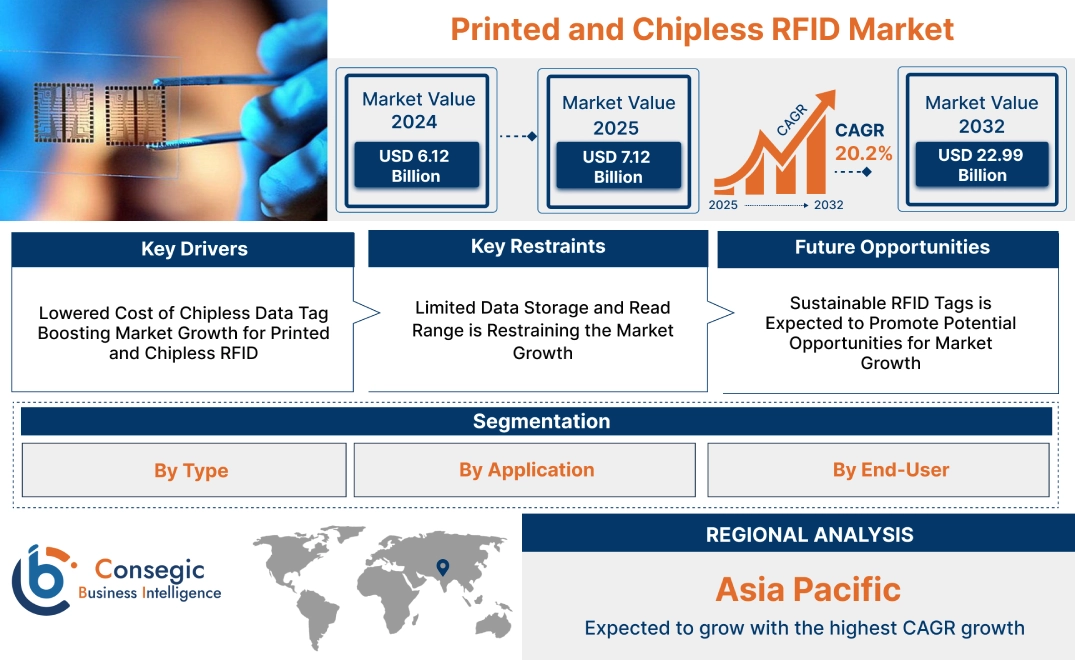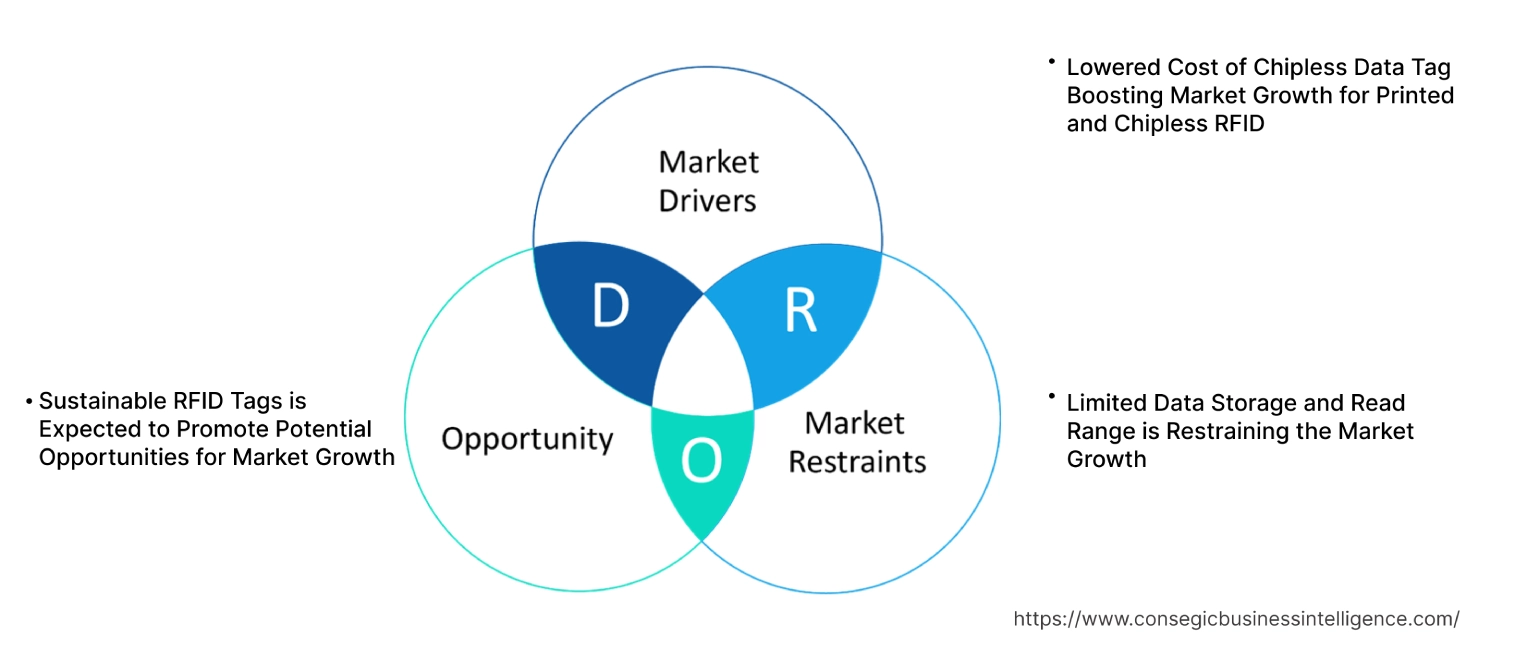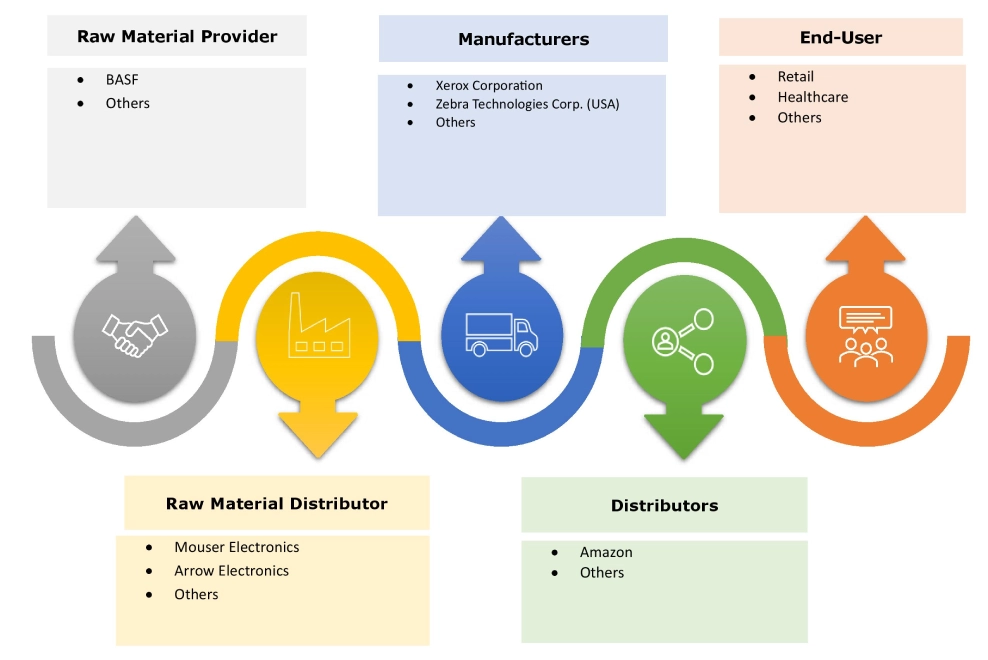- Summary
- Table Of Content
- Methodology
Printed and Chipless RFID Market Size:
Printed and Chipless RFID Market size is estimated to reach over USD 22.99 Billion by 2032 from a value of USD 6.12 Billion in 2024 and is projected to grow by USD 7.12 Billion in 2025, growing at a CAGR of 20.2% from 2025 to 2032.
Printed and Chipless RFID Market Scope & Overview:
Printed and chipless RFID is a technology in which printing technique is utilized to create RFID tags without a microchip to store and transmit data. Also, advantages including lowered cost, flexibility, and easy integration among others are driving the printed and chipless RFID market demand. Additionally, they are utilized in smart packaging, inventory management, and access control, among others. Further, the rising adoption in wearable devices and healthcare industry is driving the printed and chipless RFID market growth.
Key Drivers:
Lowered Cost of Chipless Data Tag Boosting Market Growth for Printed and Chipless RFID
Chipless data tags are significantly cheaper than traditional RFID tags due to the materials utilized in the manufacture of tags which in turn drives the printed and chipless RFID market growth. Additionally, absence of a microchip significantly reduces material and manufacturing costs in turn driving the printed and chipless RFID market demand in asset tracking applications.
- For instance, in January 2022, Vubiq Networks, Inc received a new RFID patent by the U.S. Patent and Trademark Office. The patented technology lowers costs by enabling the use of low electrical conductivity metals for the antenna elements, avoiding costly silver-based inks.
Therefore, the reduced material usage is driving the adoption of chipless RFID tag, in turn proliferating the growth of the market.
Key Restraints:
Limited Data Storage and Read Range is Restraining the Market Growth
Chipless RFID tags typically store less data compared to chip-based RFID tags in turn limiting the amount of data stored is hindering the printed and chipless RFID market expansion. Additionally, the chipless RFID tags have smaller form factor compared to traditional RFID tags in turn reducing the signal strength due to complexity hinders the printed and chipless RFID industry progress.
Therefore, the limited data storage and read range capability of tag is restraining the printed and chipless RFID market expansion.
Future Opportunities :
Sustainable RFID Tags is Expected to Promote Potential Opportunities for Market Growth
Chipless RFID tags are a sustainable alternative to chip-based RFID tags by eliminating the need for microchips and metal antennas in turn reducing the environmental impact is paving the way for printed and chipless RFID market opportunities. Additionally, tags are made from paper or other recyclable materials which significantly reduce carbon dioxide emissions in turn driving the market demand.
- For instance, in March 2025, Hana’s RFID solutions is revolutionizing tire ecosystem by reducing maintenance, improving inventory control, streamlining fleet management, and other driving the industry towards sustainability
Hence, the rising adoption Chipless RFID tags due to a sustainable alternative is anticipated to increase the utilization, in turn promoting printed and chipless RFID market opportunities during the forecast period.
Printed and Chipless RFID Market Segmental Analysis :
By Type:
Based on the type, the market is segmented into TFTC, ink stripes, radar array, SAW, and others.
Trends in the Type:
- The trend towards integration of TFTC based RFID tag with consumer electronics and smart packaging is driving the printed and chipless RFID market trend.
- The rising adoption of SAW in security and access control applications is driving the printed and chipless RFID market trend.
TFTC accounted for the largest revenue share in the market in 2024.
- TFTC offers a balance between low cost and high performance encoding and decoding capabilities as well as managing antenna.
- Additionally, advantages including flexibility, easy integration and lowered cost among others are driving the adoption of TFTC which in turn drives the printed and chipless RFID market size.
- Further, the rising adoption of wearable devices, smart packaging and others is driving the adoption of TFTC based chipless RFID tag which in turn boost the printed and chipless RFID market share.
- For instance, in August 2024, according to rock health digital health consumer adoption survey, the adoption of wearable health tracking devices such as smartwatches, smart rings and other reached 44% in America.
- Thus, according to the printed and chipless RFID market analysis, rising adoption of wearable devices, smart packaging and others is driving the TFTC based chipless RFID tag segment.
SAW is anticipated to register the fastest CAGR during the forecast period.
- SAW is surface acoustic wave which utilizes acoustic waves for data transmission and identification.
- Additionally, the advantages include educed power consumption and long range reading capability among others is driving the adoption of surface acoustic wave which in turn drives the printed and chipless RFID market size.
- Further, the rising adoption in industrial applications such as asset tracking is driving the adoption of SAW based chipless RFID tag which in turn is boosting the printed and chipless RFID market share.
- Therefore, according to the printed and chipless RFID market analysis, the rising adoption in industrial applications is anticipated to boost market during the forecast period.
By Application:
Based on the application, the market is segmented into asset management, smart cards, smart tickets, and others.
Trends in the Application:
- The trend towards rising adoption of RFID based smart tickets in public transportation in turn improving user experience and eliminating queues is driving the market progress.
- The trend towards cashless transactions and promotion of digitalization across globe is driving the market demand in smart cards applications.
Asset Management accounted for the largest revenue share in the year 2024.
- The RFID technology have the ability to track multiple assets, collect data in real-time, improve asset visibility and increase accuracy among other driving the adoption in asset management applications.
- Additionally, the growing e-commerce and logistics sector is driving the adoption of RFID technology for asset management.
- Further, the rising adoption of RFID technology for real time asset tracking is driving the market demand in asset management applications.
- For instance, in July 2023, CYBRA deployed patented IoT RFID solution called Edgefinity to Thermo Fisher to accurately track medical serum inventory in real-time in sub-zero conditions.
- Thus, as per the market analysis, growing e-commerce and logistics sector is driving the adoption of RFID technology in asset management applications.
Smart Cards is anticipated to register the fastest CAGR during the forecast period.
- RFID smart cards are widely utilized for access control, payment systems, public transport, healthcare, and identification driving the market progress in smart card applications.
- Additionally, advancements in printed chipless RFID integrated smart cards offer durable and flexible solutions.
- Further, the rising adoption of RFID embedded smart card in BFSI sector due to secure and convenient payment solutions is driving the market demand.
- Therefore, as per the market analysis, the rising adoption in BFSI sector is anticipated to boost the market during the forecast period.
By End-User:
Trends in the End User:
- The trend towards rising adoption of RFID based smart cards is driving the market progress in BFSI sector.
- The trend towards adoption of RFID tags for baggage tracking, improving efficiency and reducing the risk of lost luggage is driving the adoption in aviation sector.
Retail accounted for the largest revenue share of 29.95% in the year 2024.
- The retail sector leverage RFID technology for asset management and optimize cost.
- Additionally, the advantages include enhanced inventory management, reduced loss, streamlined operations, and improved customer experience among others is driving the market demand in retail sector.
- Further, the rise in e-commerce is driving the adoption of RFID in logistics and supply chain of retail sector which in turn drives the market progress.
- For instance, according to IBEF, the retail sales increased form 5% in September 2024 as compared to sales levels in September 2023 driving the growth of retail sector in India.
- Thus, as per the market analysis, rise in e-commerce is driving the market adoption in retail sector.
Transport & logistics is anticipated to register the fastest CAGR during the forecast period.
- The chipless RFID tags is widely utilized to track and trace goods throughout the supply chain, from manufacturing to distribution driving the adoption in transport & logistics.
- Additionally, the advantages include enhanced visibility and traceability, improved inventory management and others drive the market adoption in transport & logistics.
- Therefore, as per the market analysis, the ability to track and trace goods is anticipated to boost the market during the forecast period.
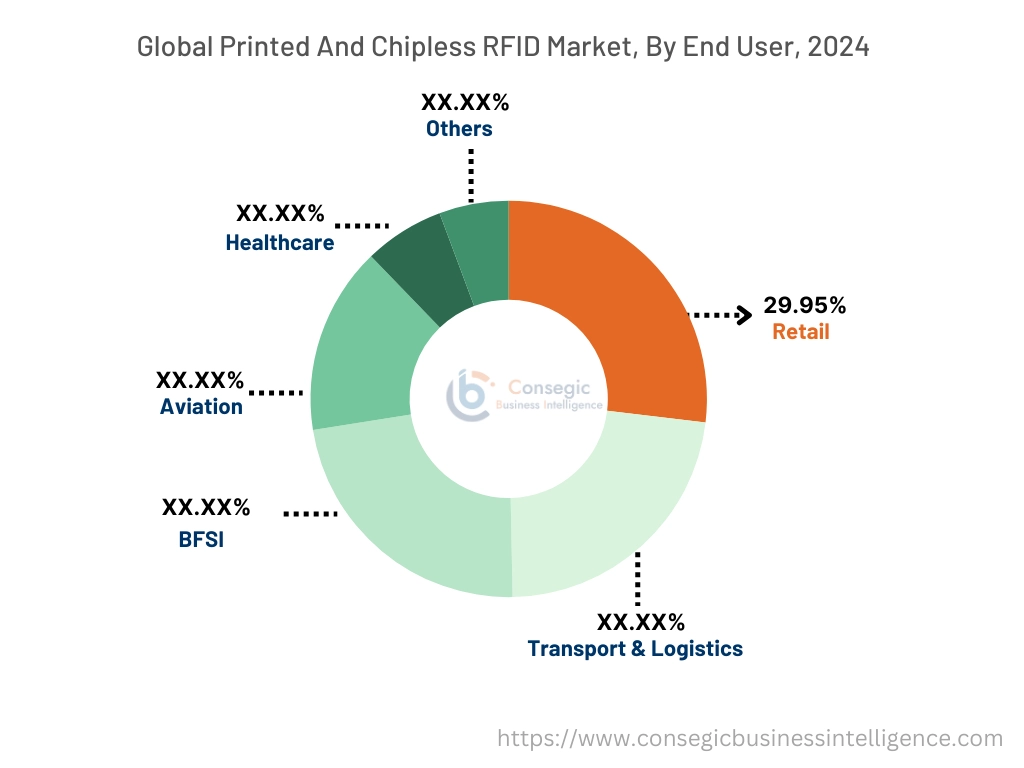
Regional Analysis:
The regions covered are North America, Europe, Asia Pacific, the Middle East and Africa, and Latin America.
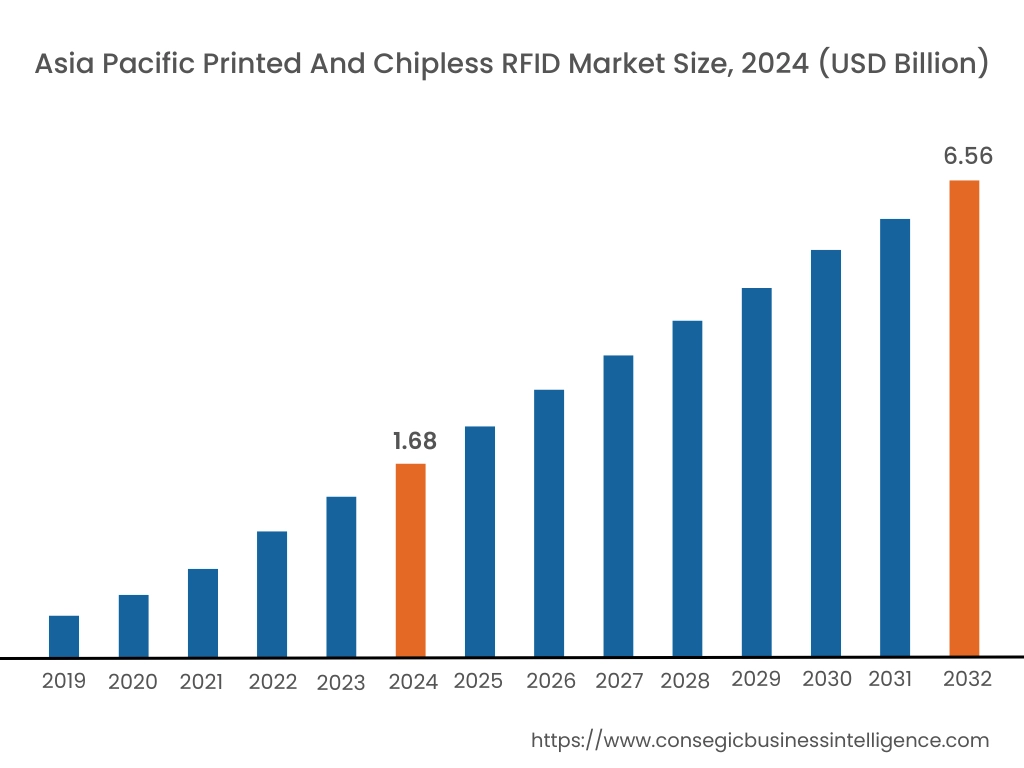
Asia Pacific region was valued at USD 1.68 Billion in 2024. Moreover, it is projected to grow by USD 1.96 Billion in 2025 and reach over USD 6.56 Billion by 2032. Out of this, China accounted for the maximum revenue share of 29.07%. The market is mainly driven by its adoption in retail and BFSI sectors. Furthermore, factors including rising adoption of IoT embedded devices and smart infrastructure are projected to drive the market progress in Asia Pacific during the forecast period.
- For instance, according to IBEF, the Indian retail sector attracted USD 4.68 billion foreign direct investment in 2020 to 2024 driving the progress of retail sector.
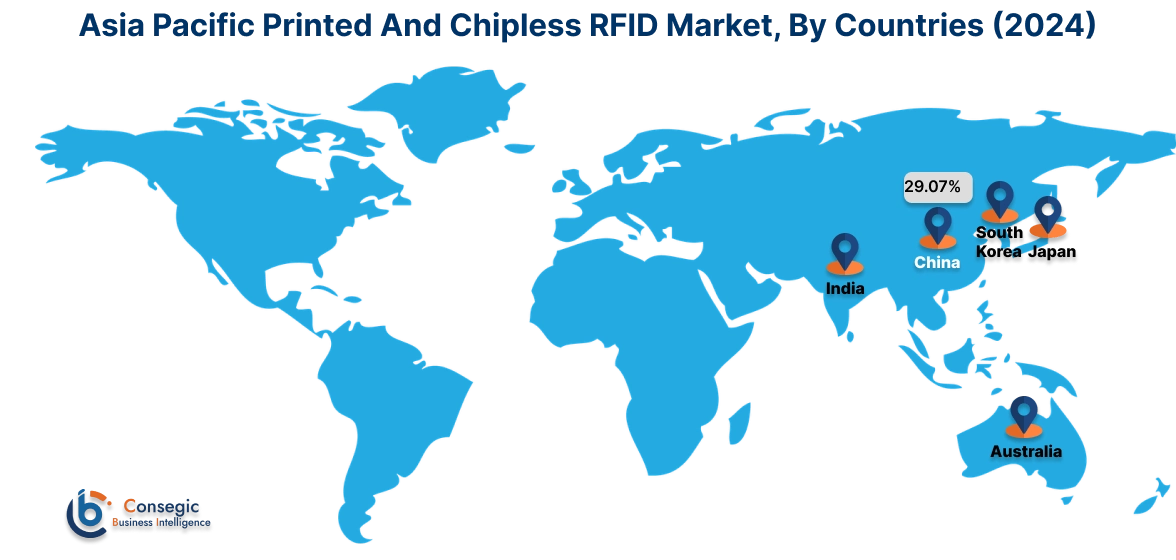
North America is estimated to reach over USD 7.52 Billion by 2032 from a value of USD 2.02 Billion in 2024 and is projected to grow by USD 2.34 Billion in 2025. The North American region's market is growing as the retail and healthcare sector offer lucrative growth prospects for the market. Additionally, the rising adoption in retail sector for asset tracking and management is driving the market progress.
- For instance, in March 2025, RADAR partnered with Gap Inc for adoption of AI-powered RFID technology across the store for real-time inventory information which in turn is improving the customer experience.
The regional evaluation depicts that the rising adoption in pharmaceuticals and luxury goods to cater forging is driving the market in Europe. Additionally, the key factor driving the market is increasing focus towards asset management and improving healthcare services in the Middle East and African region. Further, the growing retail and e-commerce sector is paving the way for the progress of market in Latin America region.
Top Key Players and Market Share Insights:
The global printed and chipless RFID market is highly competitive with major players providing printed and chipless RFID to the national and international markets. Key players are adopting several strategies in research and development (R&D), product innovation, and end-user launches to hold a strong position in the printed and chipless RFID industry. Key players in the printed and chipless RFID market include-
- Alien Technology Corporation (USA)
- Confidex Ltd. (Europe)
- Impinj (USA)
- Avery Dennison (USA)
- NXP Semiconductors (Netherlands)
- Xerox Corporation (USA)
- Zebra Technologies Corp. (USA)
- Pragmatic Semiconductor (UK)
- Technovaa (India)
- SATO Holdings (Japan)
Recent Industry Developments :
Collaborations and Partnerships:
- In October 2024, Avery Dennison partnered with The Kroger Co. for improving customer experience through RFID inventory automation technology. The technology enables accurate inventory information to reduce waste and improve the associate experience.
- In October 2023, Fresenius Kabi partnered with Diprivan to integrate +RFID smart labels into Diprivan injectable emulsion. The partnership aims to enhance interoperability as well as provide safe and efficient medication inventory processes.
Printed and Chipless RFID Market Report Insights :
| Report Attributes | Report Details |
| Study Timeline | 2019-2032 |
| Market Size in 2032 | USD 22.99 Billion |
| CAGR (2025-2032) | 20.2% |
| By Type |
|
| By Application |
|
| By End-User |
|
| By Region |
|
| Key Players |
|
| North America | U.S. Canada Mexico |
| Europe | U.K. Germany France Spain Italy Russia Benelux Rest of Europe |
| APAC | China South Korea Japan India Australia ASEAN Rest of Asia-Pacific |
| Middle East and Africa | GCC Turkey South Africa Rest of MEA |
| LATAM | Brazil Argentina Chile Rest of LATAM |
| Report Coverage |
|
Key Questions Answered in the Report
How big is the printed and chipless RFID market? +
The printed and chipless RFID Market size is estimated to reach over USD 22.99 billion by 2032 from a value of USD 6.12 billion in 2024 and is projected to grow by USD 7.12 billion in 2025, growing at a CAGR of 20.2% from 2025 to 2032.
What specific segmentation details are covered in the printed and chipless RFID report? +
The printed and chipless RFID report includes specific segmentation details for type, application, end user, and regions.
Which is the fastest segment anticipated to impact the market growth? +
In the printed and chipless RFID market, the transport & logistics is the fastest-growing segment during the forecast period due to the ability to track and trace goods throughout the supply chain, from manufacturing to distribution.
Who are the major players in the printed and chipless RFID market? +
The key participants in the printed and chipless RFID market are Alien Technology Corporation (USA), Confidex Ltd. (Europe), Impinj (USA), Avery Dennison (USA), NXP Semiconductors (The Netherlands), Xerox Corporation (USA), Zebra Technologies Corp. (USA), Pragmatic Semiconductor (UK), Technovaa (India), SATO Holdings (Japan) and others.
What are the key trends in the printed and chipless RFID market? +
The printed and chipless RFID market is being shaped by several key trends including trend towards integration of TFTC based RFID tag with consumer electronics and smart packaging and other are the key trends driving the market.
